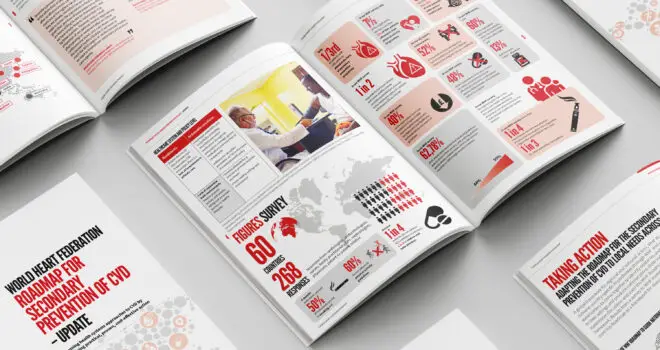High blood pressure is one of the major risk factors for CVD. It affects 1.2 billion adults in the world, which means that 22 in 100 adults are hypertensive. The World Heart Federation (WHF), together with the Colombian Society of Cardiology and Cardiovascular Surgery (SCCCC), held a Roundtable in Bogotá, Colombia on 28 January based on WHF Roadmap for Reducing Cardiovascular Mortality through Prevention and Management of Raised Blood Pressure to identify obstacles and find solutions at the national level.
The WHF Roadmap on Raised Blood Pressure was developed by experts and Members to help identify the roadblocks to treating hypertension, which is currently preventing the SDGs from being achieved. A key challenge in effective raised blood pressure control is that most hypertensive individuals are usually asymptomatic for years prior to a significant cardiovascular event, but face an increased risk of stroke, heart attacks, and kidney disease. Raised blood pressure is one of the most frequent reasons for consultation in primary care and, left untreated, can lead to a range of complications including myocardial infarction, stroke, heart failure, renal failure, and death.
To advance efforts towards the control and management of hypertension in Colombia, WHF and the SCCCC developed the following guidelines:
1. Implementation of the National Registry of Arterial Hypertension
Develop a strategy to identify the incidence and prevalence of arterial hypertension in Colombia.
- Determine the actual figures of hypertension at the local level and the epidemiological characteristics of patients affected by arterial hypertension, who will be included in targeted prevention models. This will help reduce the final costs incurred by therapeutic intervention care.
- Maintain a register with national data in order to implement interventions. This must be led, monitored and supervised by the Ministry of Health in order to obtain statistics.
- Unite efforts and coordinate all the stakeholders in the health system to achieve a health model focused on the population and to strengthen existing databases in order to generate a single data set.
2. Standardization of blood pressure measurement
Standardize and educate the medical community in the correct way to measure blood pressure.
- To implement strategies that provide health care centers with the appropriate tools for blood pressure measurement, in order to optimize resources and avoid inaccurate blood pressure readings.
- Digital blood pressure measurement should be standardized at the national level, which will help the country to know its numbers and make progress in the diagnosis and patient access.
3. Global strategy for community education
Implement strategies that inform the affected community about the disease and its immediate and future implications.
- Educating the population is fundamental. Didactic strategies should target patients living with high blood pressure, their caregivers and the community in general and focus on the metabolic, psychological and pathological impact of hypertension. This will generate greater awareness of the condition, self-care, and self-management of cardiovascular risk and an increased commitment to non-pharmacological management.
- All health professionals (general practitioners, internists, dentists, nurses) should measure the blood pressure of their patients, in order to advance in the early diagnosis.
4. A national campaign to reduce consumption of sodium-rich foods
Develop and implement community-based campaigns to reduce sodium consumption in order to positively impact the control of modifiable cardiovascular risk factors (non-pharmacological management).
- Create communication strategies to make the public aware of the risks of sodium consumption.
- The work carried out by the Ministry of Health should be reviewed in order to contribute to its implementation.
5. Global Strategy for Early Detection of High Blood Pressure
Implement strategies for the search and identification of hypertensive patients.
- Early initiation of therapeutic strategies can be optimized and improved so that the clinical course of each individual is more favorable. In this way, we reduce the progression of the disease to terminal stages in affected organs.
- It is necessary to influence public health policy in the case of hypertension. These search and identification strategies should be applied in the public insurance system and programmes with assigned populations should report existing cases of hypertension.
- Working groups should be formed in conjunction with academia.
- The Ministry of Health can make recommendations to achieve the best standards for the detection of hypertensive patients.
6. Global Strategy for access to health technologies on hypertension
Promote public policies that allow the community to have access to health technologies regarding pharmacology and medical intervention strategies.
- Improve access to medicines for hypertensive patients, in fixed single-dose combinations, and increase the participation of scientific societies in the formulation and implementation of public health policies.
- Provide all care entities with the necessary and adequate technology for the correct measure of blood pressure, since management plans, state policies and, most importantly, impact on the patients are derived from them.



